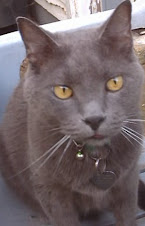Decorative edges were covered in my previous class, but I called on a professional, Ingrid Dijkers, who actually teaches workshops (you know, the kind you PAY for) in which she holds classes in this very subject. Maybe some of you have seen her work. Maybe some of you have taken her workshops. If not, you are in for a treat when you visit her blog and web site.
I really tried when I recreated this technique. I spent most of the night making it and it was a disaster from the first stitch. I began by painting both sides of a three-page block with brown antiquing ink and gold acrylic fluid. When dry, I punched holes according to Ingrid's instructions. From there everything went downhill.
Since I don't hand sew, I didn't know how to start the wire and how to keep it attached. After fiddling with that problem and eventually cutting the wire and starting over, I promptly tied the wire too tight and broke through the very first hole. After patching that, I started again, this time being more careful. As I worked, I wasn't sure how to attach the buttons, even though I looked and looked at Ingrid's photos. I seemed to have worked outward rather than down the page, and I would have run out of buttons and made the page floppy if I'd continued in that vein. Also, my buttons never laid flat. It might be because I wasn't working outside the book and didn't have a good surface to lay the pages and buttons assembly on. Finally my wire kept twisting, even though I was very careful each time I threaded a button, so I was never able to tighten the wire like it needed.
I also auditioned two different colored wires. I forgot that Ingrid suggested using paddle wire, so I chose gold 24 Ga. craft wire.
Using a manageable size piece of wire (I use about 18" at a time), start wiring buttons on. Make sure they are securely wired so they lie flat. You may have to go in and out of the holes of the page and the buttons several times.Ingrid Dijkers, May, 2009
I do like the house I made, though. I call it the Hugs and Kisses house. I used some textural scrapbook paper, a piece of cloth that I attached a "Kisses" tag to, a pink and white heart, three heart buttons, sheet music, two pink and white bows, a part of a page from an old Quality Assurance manual, and a couple of left-over hearts I cut from the next project.
Be aware, these triangles are glued together except at the bottom, where the the edges are attached on both sides of the page. Thus the need for the ribbon. They are the same colors on both sides of the page. I just haven't decorated the back of the page yet, so have nothing to show. If you are a scrapbooker and have double sided paper, that would be a much smarter and more efficient way to go. Unfortunately, I don't have any double sided paper, so opted for coloring, decorating, and cutting the triangles by hand. You also might not want your decorative edges to stick so far away from the edge of your page. Remember, it's YOUR book and YOUR rules.
Here are a few more ideas, some of which I mentioned earlier: flat washers, beads (purchased, made from polymer clay, hand made), die cuts, flowers (either paper or silk), screws, or other bits that will lay relatively flat against the page.
Now it's time for you to create a decorative edge in your AB. If you don't have enough pages in your book, you can practice on a tag, OR return to a page that could use a bit of decorating around the edges.
Also, at least one of you is a professional beader (I promise not to mention any names, Debbie), so possibly she could document how she made her edge and can show the rest of us how it SHOULD be made.
HOMEWORK
Before I suggest the homework (never mandatory, always optional), please vote for what you would like for Lesson 18. This is the Student's Choice lesson, as stated in the syllabus. Please state your preference in the comment section. The lesson with the most votes wins.
Create at least one spread in which you decorate an edge. Remember, you can use any page, even ones that have been previously decorated. Just be aware, you will design this for the FRONT of a right side and the FRONT of a left REVERSE side. Alternately, if you have no pages, feel free to decorate a tag using one of the techniques I suggested.
What you will need for Lesson 16:
Once again your instructor is changing the order of the lessons. According to the syllabus, this should be the order in which these next two lessons are taught:
Lesson 16However, after reviewing the class I taught before, I realized I included both fabric and polymer clay in one lesson. I began with polymer clay and finished by using the clay as examples when I created my fabric pages. Therefore, I am reversing the order in which these lessons will be taught. You will still get the same lessons, they will just be reversed.
Beyond the Basics: fabric
Lesson 17Beyond the Basics: polymer clay
I realize some of you work with polymer clay a LOT, while some of you have never worked with polymer clay in your life. Those of you who own polymer clay making equipment are certainly welcome to use them. This is what you will need:
Pasta maker
Toaster oven designated for baking polymer clay
Craft or X-acto knife
At least ONE package of clay (color of your choice)
Alternately, you may want to use Translucent Liquid Sculpey to make image transfers
For those of you who don't have the above tools, here is what you will need if you decide to play along:
2 or more paint stirrer sticks or a deck of playing cards
A length of PVC pipe (from the hardware store), or a round, straight bottle
2 pie tins, the same size, or a shallow metal decorative tin with a lid
Binder clips, at least two
Straight edge razor blades or an X-acto knife
At least one package of polymer clay
Most of you will have these items, except the clay. You might also want to include these optional items:
Latex gloves (because certain polymer clay colors your hands, and because the gloves keep fingerprint marks to a minimum)
Rubber stamps
Any mica powder (does not need a resin binder)
Old paint brush
Texture plates
Cookie cutters no longer used to cut cookies
Candy molds no longer used to make candy
It's share time!
Now is the time to share your Lesson 14 homework (windows and doors). This seemed to be a popular lesson, so I hope we get a good response. I know some of you are probably anxious to show what you have made. Remember, if you have homework from any lesson other than Lesson 14 (windows and doors), you may enter it here, along with the lesson number. Thanks again for your continued support. It is always appreciated.
_________________________________________








.jpeg)









































































.JPG)

























30 thoughtful remarks:
Amazing...I need a much longer day to learn, create & play. TFS...
Ooooh Elizabeth, what a fab lesson, thank-you so much. Lol, think I will be avoiding buttons tbh, quite happy gluing them on but absolutely useless when it comes to wiring things together ha ha. I'm sure I will think of something else to do.
Mind you!! I still have to catch up with my window/door pages yet!!
I have no ideas at the mo ref suggestions for lesson 18, I am so delighted with the things we have coming on the syllabus anyway but I will keep thinking on it.
I have attached my zipper pages for you, got there eventually.
Hope you are well my lovely?
Big hugs x x x x
I like the button page edges... something I would never have thought of in a book. I love the second project with the dark colors and triangles!
Elizabeth,
so far I haven't made so much as one page in my alteredbook, but I hpe to soon.I like what you did with the butons. Thye are great. I would like to see some book pages you sew on since you like to sew so much.
XX Rachel XX
Buttons button buttons, I LOVE buttons. I have a big tin full of old buttons (shame we can't use shank ones though as I have some lovely old glass ones).
I cut round my ric-rac on my right hand sunflower page and may just add the button edge there as you suggested. Was going to add it on my New Year page BUT the holes would go through my Valentine lettering!
Off to sort through my buttons. Thanks BJ
Oops sorry, in my enthusiasm for buttons forgot my suggestion for lesson 18 but together with Dawn I'm afraid I don't really have anything to suggest. I Have been totally enthralled with all the lessons so far so I just wouldn't know what else could be used?
Although what about a pop-up thing as you open the page?
Gosh where did that come from?
Have to add I'm am quivering a bit about next lesson as the modelling clay is totally alien to me (even more so than paint). Even the list of things I should have at home is challenging! I guess I best wait and see what it is all about next time before going to the shops.
Thanks as ever - BJ
Small hitch, no strengthening cardboard edge on my sunflower ric-rac page! Although now I have also cut the other ric-rac edge as I thought the scallopped edges look cool, and it didn't upset the previous autumn page. BJ having a rethink.
always informative tutorials...it is wonderful how well you express your trials and frustrations with projects. it shows honestly how things can be trying when we attempt something new, but your second button edging was a great improvement and looks terrific! many bloggers only show the finished product without any mention of difficulties or less than perfect results. great post!
Hi Elizabeth, no you didn't mislead me, how could you possibly know if my page was strong enough. Anyway, as I said I re-thought things and had a look at the link you offered and ended up doing a beaded edge on the sunflower page, the ric-rac added enough strength. No idea how to start it let alone finish it off, but for the middle bit I did Blanket Stitch with some gold coloured beading wire and used some lemon angular beads along it. Ohh really pleased with how it has turned out, what a super technique, want to add it to all my pages now - LOL - BJ
Baked! - you must be joking I am a disaster in the kitchen! Might have to skip that lesson and do more decorative edges - LOL
Just blogged my edge if you can't wait a fortnight (2 weeks - LOL) - BJ
Wow Elizabeth, I have to give you 10 out of 10 for perseverance with your button page. It does look beautiful, I love the effect that white buttons gives. I do think that they would add something to one of my previous pages so I might try it there as you suggest.
Suggestions: Pop ups is one as BJ suggested, I would love to know about paper carving/sculpture but you need lots of pages and it can be quite complicated, transfers (always have problems with those, drawers though I think the process is similar to your lesson to create a niche. Your have covered so much in your lessons that I can't think of anything else. Thanks Elizabeth
Hi Elizabeth, just reposted my zipper here, sorry the order of your lessons confused me, and that's not hard to do.
The button edge looks a bit difficult, I might just manage the triangles though. Once again you posted a terrific tutorial.
Darla
I really like the button edging and I think you did a good job attaching them. It is really hard to create a definite pathway--I sort of like the meandering. The buttons reminded me that I'd like to make a page with the buttons on it, too--I'll show it when finished. The paddle wire that I have is 28 gauge. I'm sure you know...the lower the number, the thicker the wire. There are colored wires that come in 26 gauge and also aluminum wire would be softer to work with than copper wire. I do get that you are all about using what you have...me, too! Of course I have a ton of wire in loads of colors..just let me know & I'd be happy to share some with you.
Professional beader? Me? I laughed out loud when I read this! Maybe from the flower standpoint, but I'll see what I can come up with for an edging.
I like to play with polymer clay when I need a break from beads, so I'm anxious to see what's in store there.
Your course has been so comprehensive, it is hard to think of something I do like the idea of a pop up!
Lovely post ~ and your button creation is fascinating ~ commend you for your perseverance ~ this is a lot of work! Wonderful tutorial ~ yet not my 'cup of tea' ~ Enjoy the week ~ (A Creative Harbor)
I have added two links. more pockets because it was in the box for posting so either I forgot to press enter last time or something and now the windows one. Anyway I am going to luv this next lesson but I think zippers is going to be a no show!
i really like the buttoned edges..i think i prefer the wired on version
thanks for such details!
Ooooh I love the button edge... sorry it was such a pain to do, it looks fabulous!! I did wonder if the wire was too thick which might give you problems but i guess I will find that out when I have a go at this!! I wonder if sewing them on with thread would be any easier? I am going to have so many fabby techniques to catch up on when I unearth my altered book again!! The zipper and the buttons are going to the top of the list... I really want to play with both!!
I was wondering about the buttons being sewn on with thread as well. It seems more compatible with paper! pop ups is good. But I have never done much with transfers, either. I really do like the buttons on your edge.
I knew I wouldn't need to to leave you long before you got up to some mischief!! I love your button edge and your commentary with it, you know all that stuff they never tell you to look out for, traps for young players etc, it's all good to know! Your page was worth all the hassle and I hope you finish it. The rumpled pages have also taken the colour really well, really interesting effect. Mx
Thought I'd add my penny worth with regards thread vs wire. I think thread would be fine for a simple bead edging but having done mine in wire I can see the benefits of wire in that it leaves the edging rigid. I think that is the key for the button edging the rigidity of it so it lies flat and in line with the page and not floppy. BJ
As for British oven temperatures, electric ovens do have the temp in F or C but would you know I have a GAS oven and they are done in Marks 1-9! Typical.
I was thinking I could buy some Fimo modelling clay for the next lesson but as it is polymer clay you specify I have absolutely no idea what that is - let alone the difference.
BJ
Hello Elizabeth, I am so sorry my fat fingers hit the delete button instead of the publish button on the comment you send for my zipper. I know you are busy but would you mind sending it again Please!!!!!
I've always loved Ingrid's journals. I watched you struggling with attaching the buttons but I must say, if you had not mentioned how difficult it was and your mistakes, I would never have seen them. I think your button work is spectacular! I also love the page you created with the bronze splotches-must be irridized acrylic? Very nice. Thanks for this invaluable lesson in finishing edges.
i LOVE the green page with the buttons!!! i want to do that...the gold wire looks amazing
I think your buttons look amazing! I love the idea of having them along the edge of a page in your AB.
I think your button edge looks great!! I'm pretty sure I've only used that technique once....as homework for your class the first go round. It's fussy work but well work the time I think.
This edge looks awesome, thank you for sharing the tutorial.
Those buttons are stunning on the edge of your page!! I have way too many buttons and this is the best idea I've seen yet to use them up!
Post a Comment